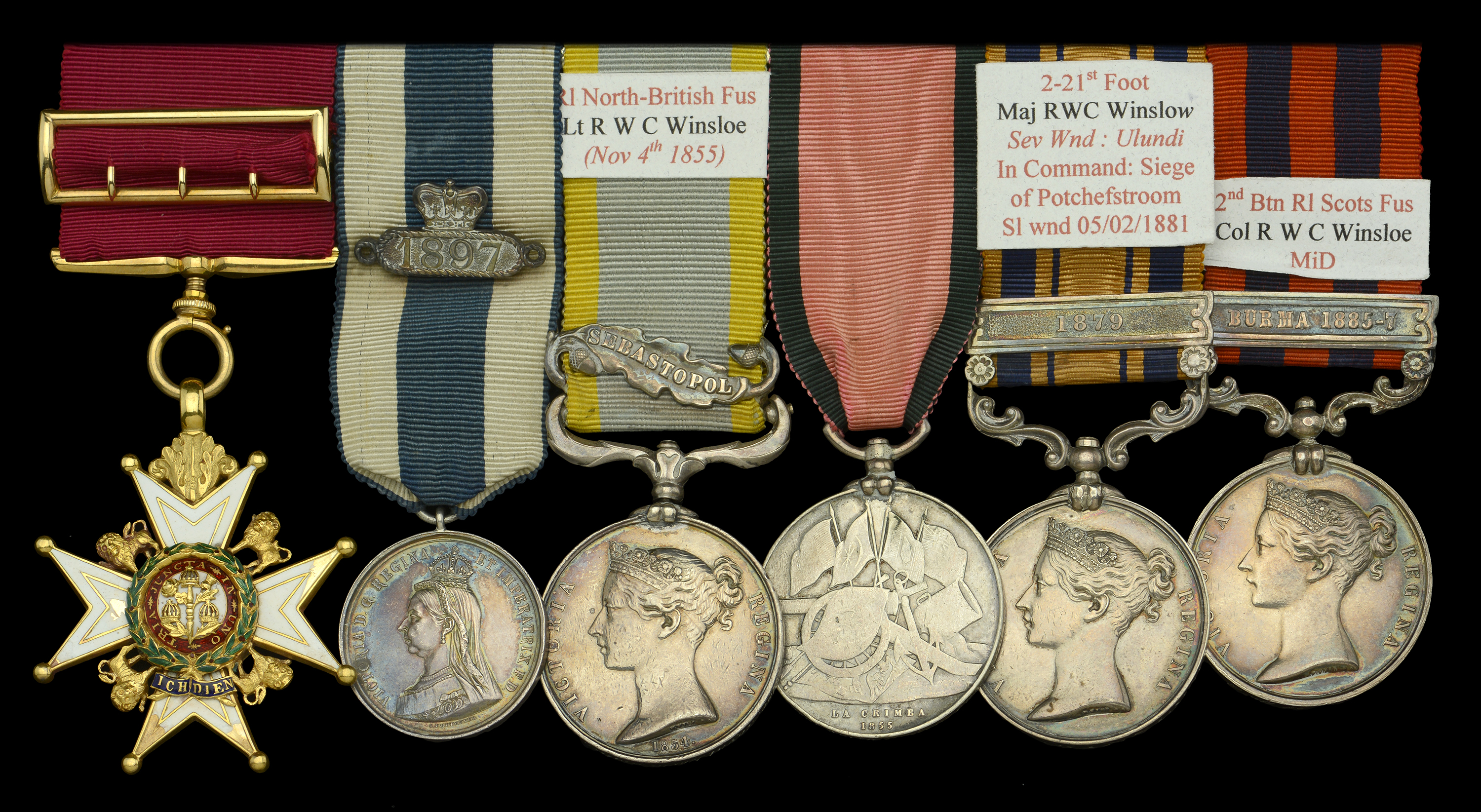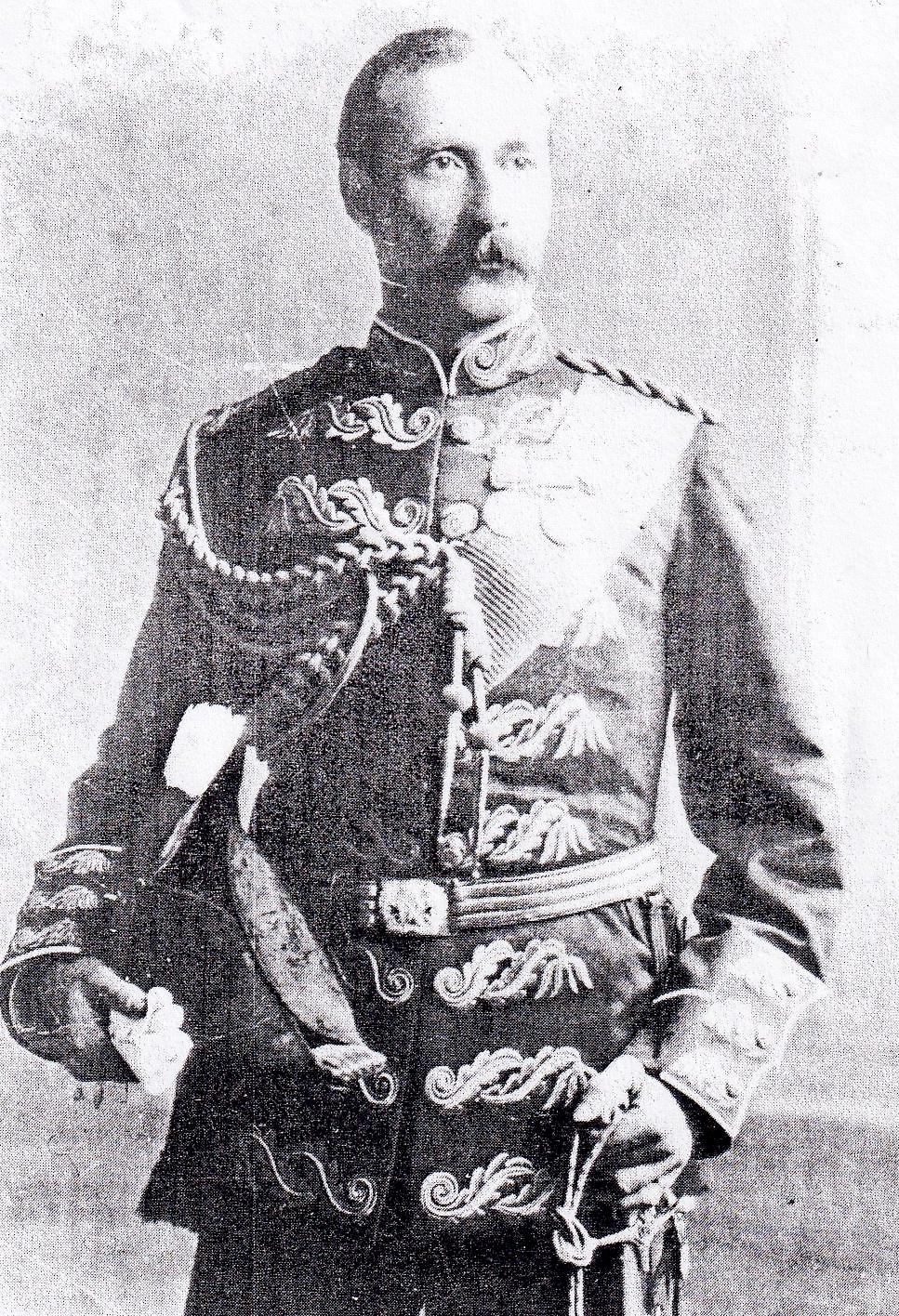The important C.B. group of six awarded to Colonel R. W. C. Winsloe, 21st Regiment of Foot, later Royal Scots Fusiliers, who Commanded the Garrison throughout the Siege of Potchefstroom during the First Boer War, for which services he was appointed Aide-de-Camp to Queen Victoria; having previously distinguished himself in the Crimea, and been severely wounded at Ulundi, he later commanded the 2nd Battalion Royal Scots Fusiliers in Burma, and was three times Mentioned in Despatches The Most Honourable Order of the Bath, C.B. (Military) Companion’s breast badge, 18ct gold and enamel, hallmarks for London 1875, with integral gold riband buckle; Jubilee 1887, clasp, 1897, silver, unnamed as issued; Crimea 1854-56, 1 clasp, Sebastopol (Lieutenant R. W. C. Winsloe, Royal North British Fusiliers, November 4th. 1855.) privately engraved naming; Turkish Crimea 1855, Sardinian issue (Lieutenant R. W. C. Winsloe, Royal North British Fusiliers, November 4th. 1855.) privately engraved naming, plugged and fitted with a small swivel ring suspension; South Africa 1877-79, 1 clasp, 1879 (Major R. W. C. Winslow [sic]. 2-21st. Foot.); India General Service 1854-95, 1 clasp, Burma 1885-7 (Col. R. W. C. Winsloe. 2d. Bn. R. Sc. Fus.) mounted for display in this order, enamel damage to CB, edge bruising and contact marks, nearly very fine and better (6) £6,000-£8,000 --- C.B. London Gazette 25 May 1889. Richard William Charles Winsloe was commissioned Ensign, by purchase, in the 15th Regiment of Foot on 11 June 1853, and was promoted Lieutenant on 6 October 1854. That same year he transferred to the 21st Regiment of Foot, and the following year went with the Regiment to the Crimea. He distinguished himself before Sebastopol on the night of 15 August 1855, with the following account published in the Ayrshire Post some 30 years later: ‘On the night of 15th August 1885 [sic, for 1855], the Fusiliers furnished the duties on the extreme left of our position in the advance trench. The party numbered about 300 of all ranks, 100 of whom were detached under the command of Lieutenant Winsloe (now Colonel 2nd Battalion R.S. Fusiliers), into the Grave Yard. This was the most advanced position on the British left attack, and could only be occupied during the night. It was situated on the left front of, and under our fifth parallel, on the low ground between the British and Russian batteries, cutting across the head of the Picket House Ravine, and extending almost under the muzzles of the Russian guns. The party could only enter it when dark, retiring from it again at daybreak. On the above night we had taken up our position as described, Lieutenant Winsloe posting a strong line of double sentries a considerable distance in front to guard against surprise. The night was very dark, thus requiring increased vigilance on the part of all. About an hour after midnight, Lieutenant Winsloe, with escort, went out visiting the sentries, when a sound caught his ear. He soon discovered the cause. The enemy were forming up on the plain in front of their creek battery, some of whom had already begun to move forward in the direction of our trenches. Under the cool directions of this young officer our sentries delivered their fire, when all retired within the trench in a most orderly manner and then lined the parapet ready to defend the same. The fire was repeated along the whole line of sentries in front of the advance trench above us. The enemy, seeing that our men were on the alert, did not advance further. Thus a well-organised sortie was frustrated by the cool and daring conduct of Lieutenant Winsloe. The object of the enemy in thus trying to steal upon us on this occasion was to divert British attention away from the attack which they were about to make on the French and Sardinians on the plains of the Tchernaya. It was now about daybreak, and heavy firing could be heard from the direction of the latter. Our party, under Lieutenant Winsloe, now retired from the Grave Yard, and marched to the camp, there to be ready to fall in at a moment's notice to reinforce the French and Sardinians, who were then engaged fighting the ever-memorable battle of the Tchenaya.’ Promoted Captain on 25 June 1861, and Major on 31 August 1874, Winsloe then proceeded with his Regiment to Natal in February 1879. At the Battle of Ulundi, on 4 July, the regiment formed a portion of the right of the hollow square, and with the 58th, bore the brunt of the first desperate onslaught of the enemy, large numbers of whom got to within thirty yards of the line before their advance was stayed. Severely wounded in the chest during the engagement, Winsloe was Mentioned in Despatches (London Gazette 21 August 1879) for his services, and was promoted Brevet of Lieutenant Colonel. Following the Zulu campaign, the Regiment was sent to the Transvaal and was at Pretoria at the outbreak of the Anglo-Boer War 1880-81. In December 1880 Colonel Winsloe was ordered to relieve the officer in command at Potchefstroom, arriving on 12 December. Four days later, the Boers launched their attack on the fort, which continued until its surrender on 21 March of the following year. The following extract is taken from Sir H. Mortimer Durand, A Holiday in South Africa, Part IV, Potchefstroom, Blackwood's Magazine, November 1910: ‘There during the course of the unhappy war of 1881, a war remarkable for some painful defeats inflicted upon British troops, and closed by a humiliating peace, a small body of our country men redeemed by a very brave feat the honour of our arms. It is the "Old Fort", in which for three months 140 men of the Scottish Fusiliers, with some artillerymen and a few civilians, held their ground against the attacks of an enemy very superior in numbers. Their only defences were a hastily raised line of earthwork. They were encumbered with women and children and camp-followers. The hot season was upon them and made life a misery. Their supplies and water was insufficient. The round-shot and rifle-fire of the enemy, who had good cover in almost every direction, searched the enclosure side to side, and forced the garrison to take shelter in holes dug under the "wall", the little tents they had put up at first being soon riddled with bullets. From first to last they lost more than a third of their number in killed and wounded, and there was much sickness. Yet under the command of a brave and capable officer, Winsloe, they held out till they were practically without food and even then the enemy brought about their surrender only by a breach of faith which was condemned and repudiated by the Boer Government. It is a fine story, and an Englishman who stands in the little grass grown square, now neglected and almost forgotten, cannot but think with pride and gratitude of the men who held it so long. The war of 1881, for which we were as usual not ready, and the peace which, as even its apologists admit., brought upon us the contempt of our brave enemies, are not pleasant things to think of. One thanks God that a British officer was found in this time of need whose one thought was to do his duty and keep the flag flying. He was not the only one, for our small garrisons in the Transvaal all held out well: but their trials and sufferings were not so great.’ A District Order issued by Colonel Bellairs, C.B., on 7 April 1881 (as quoted in Winsloe's own book Siege of Potchefstroom) states: ‘The fort at Potchefstroom capitulated on the 21st March, but only when its garrison was reduced to extremity, and after as brave a defence as any in military annals; the troops marching out with the honours of war, and proceeding through the Orange Free State to Natal. The sterling qualities for which British soldiers have been so renowned have been brilliantly shown in this instance, durin...









